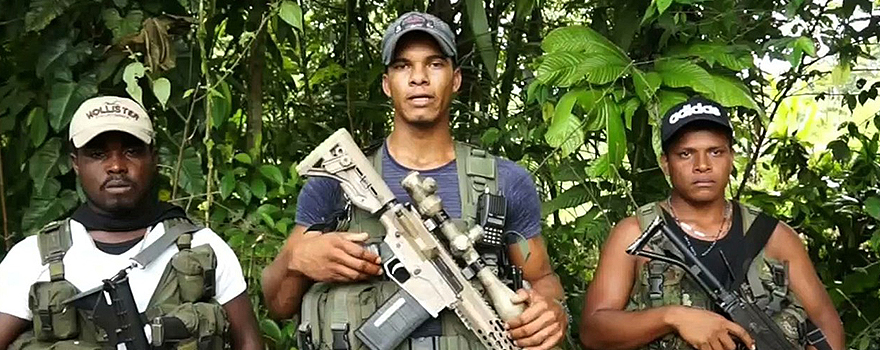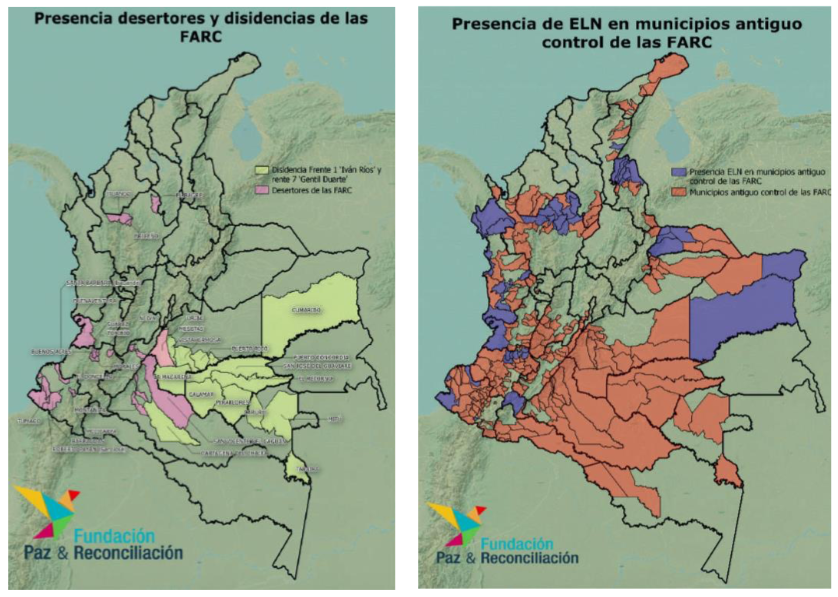The group has 2,000 members, including demobilized elements returning to arms and new recruits.
-
Coordination between FARC residue and ELN detected, with participation of "demobilized" members of the old guerrilla leadership such as Iván Márquez.
-
Iván Duque's government reacts to U.S. pressure with the committed eradication of 70,000 hectares of coca crops
-
The highest concentration of coca production on the border with Ecuador pours violence on this country, where throughout 2018 acted "el Guacho", exFARC

▲ Walter Patricio Arizala, alias "el Guacho", before falling in a Colombian Army operation.
report SRA 2019 / María Gabriela Fajardo[PDF Version]
APRIL 2019-The doubt that existed when the Colombian peace agreement was signed in December 2016, about whether the dissidence of the FARC (Revolutionary Armed Forces of Colombia) would be something residual or rather would reach a certain entity, assuming a clear security problem, has been cleared. The dissidents have been growing in issue progressively and throughout 2018 they have consolidated their criminal activity.
In the first half of 2017, some 6,800 FARC guerrillas were demobilized following the submission of nearly 9,000 weapons. The government estimated that of the total number of FARC troops, some 400 fighters (a residual 5%) were likely to refuse to follow the instructions of the guerrilla leadership. In November 2017, on the first anniversary of the signature the Havana agreement , the Peace and Reconciliation Foundation published a report estimating that dissidence had reached around 700 members. In February 2018 the Ideas for Peace Foundation raised the figure to between 1,000 and 1,500. At the end of 2018 two intelligence reports, both disseminated by Colombian media that claimed to have had access to their contents, placed the dissident bulk between 1,750 and 3,000 troops.
The highest figure in this range was established by a report released in October, of which hardly any details were given, while the lowest was provided by an alleged Defense department document submitted to congress and revealed in December. The latter fixed the issue of members of all illegal groups in the country at 7,260, of which 2,206 belonged to the ELN (National Liberal Army, the last guerrilla group as such still active in Colombia), 1,749 to the FARC dissidence and 1,600 to the Clan del Golfo, an organized crime group . If both estimates on the size of the dissidence really come from government agencies, we would be facing a lack of contrasted information on the part of the State, although everything could be due to the fact that the reports were elaborated at different times, besides not corresponding to the time of their diffusion in the media.
In view of the evolution of the phenomenon, it would probably not be wrong to think that at the beginning of 2019 the issue of FARC dissidents could be around 2,000. This Issue includes both people who never demobilized and ex-combatants who took up arms again in the face of the difficulties encountered in the transition to civilian life, as well as new recruits.
Reorganization
With the political banner transferred to the new Revolutionary Alternative Force of the Commons (which thus maintains the FARC acronym), the dissidents no longer have the narrative of social struggle that previously accompanied the activities they continue to carry out: drug trafficking, smuggling, extortion and other illicit businesses. So they have become another example of organized crime, articulated in different groups that, although they are converging, do not have the hierarchical structure of the old guerrilla leadership.
The leadership could be strengthened if some of the leaders who have expressed disagreement with the implementation of the peace process and have disappeared for some time, such as Iván Márquez, return to the guerrillas. For the moment, in any case, what is being observed is rather an organizational confluence with the ELN. Thus, several media outlets published in December 2018 about that coordination, aimed especially at getting cocaine shipments out through Venezuela, a country where the ELN has increased its activity. Army commanders have confirmed this cooperation. In addition to Iván Márquez, other FARC leaders who had supposedly laid down their arms, such as El Paisa and Romaña, participated in a high-level meeting .
These contacts took place after the talks between the government and the ELN, opened on Ecuadorian soil to explore a peace agreement , were suspended in September by decision of President Iván Duque when no progress was made and it was understood that, in reality, the ELN were getting stronger, occupying territories formerly controlled by the FARC. The dialogue was broken off following the ELN attack against the General Santander National Police Cadet School in Bogota on January 17, 2019, which left 21 dead and 80 wounded.
On the other hand, the demobilization of the FARC, although incomplete as we can see, has given rise to the presence in Colombia of Mexican cartels, which are thus trying to extend their dominance to cocaine production sites as well, something that has been highlighted by the Attorney General of the nation.
|

Map 1: yellow, FARC front that did not accept the peace agreement ; pink, deserters who did not join the agreement.
Map 2: blue, ELN presence in municipalities formerly controlled by FARC; red, municipalities formerly controlled by FARC.
|
Coca and domain disputes
Among the priorities of the new government of Iván Duque, who position office in August 2018, has been to try to reduce the high production of coca leaf and cocaine, which has risen sharply in recent years. Between 2013 and 2017, the issue of hectares under coca bush rose from 48,000 to 171,000 hectares, according to the United Nations Office on Drugs and Crime. The United States makes these estimates upwards for the same period: from 80,500 to 209,000 hectares (the latter figures would have meant a jump in potential cocaine production from 235 to 921 tons).
The outgoing government of Juan Manuel Santos committed in March 2018 to the guide eradication of 70,000 hectares of coca bush over the course of the year (compared to the 52,000 that, according to Colombian authorities, were eradicated in 2017), in the framework a five-year plan agreed with the United States, whose administration had complained about the substantial increase in cocaine production in the country in recent years. The Colombian Ministry of Defense announced that as of June 2018, 42,000 hectares had been voluntarily replaced, according to the latest report of the United Nations Office on Drugs and Crime, which, for its part, certified that between May 2018 and January 2019 almost 35,000 hectares had been eradicated. These figures represent over 90% compliance with the Comprehensive National Program for the Substitution of Illicitly Used Crops (PNIS) in various Departments. However, the urgency to achieve the objectives of reducing production space could be leading to forced eradication, not followed by other plantings, which in the medium term could mean a return to coca cultivation.
The number of murders of social leaders and human rights defenders continued to rise in 2018, reaching a record issue of 164. According to the Ombudsman's Office, from the beginning of 2016 to the end of 2018, more than 420 activists who developed a leadership role in different communities in the country were killed. This violence is related to the territorial reorganization of criminal groups. There was a particular incidence in some Departments with access to the Pacific, such as Cauca and Nariño, where a greater concentration of cocaine production and the initial demobilization of the FARC caused tensions between criminal organizations to ensure dominance of the territory. These frictions caused casualties among community leaders who wanted to free themselves from the control that cartels and criminal groups had been exerting. Meanwhile, a total of 85 former FARC members have been killed since the signature of the peace agreement , according to a 2018report by the United Nations High Commissioner for Human Rights in Colombia.
Increased criminal activity in the border area with Ecuador, with a cocaine export hub in the port of Tumaco, has led to violence spilling over to the other side of the border. In early 2018 several attacks on Ecuadorian police and army installations, as well as several kidnappings, were attributed to FARC dissidents led by "el Guacho." Colombia and Ecuador proceeded to increase the deployment of soldiers along the border to address the status. In December 2018 "el Guacho" was killed in Nariño by a Colombian Army unit.